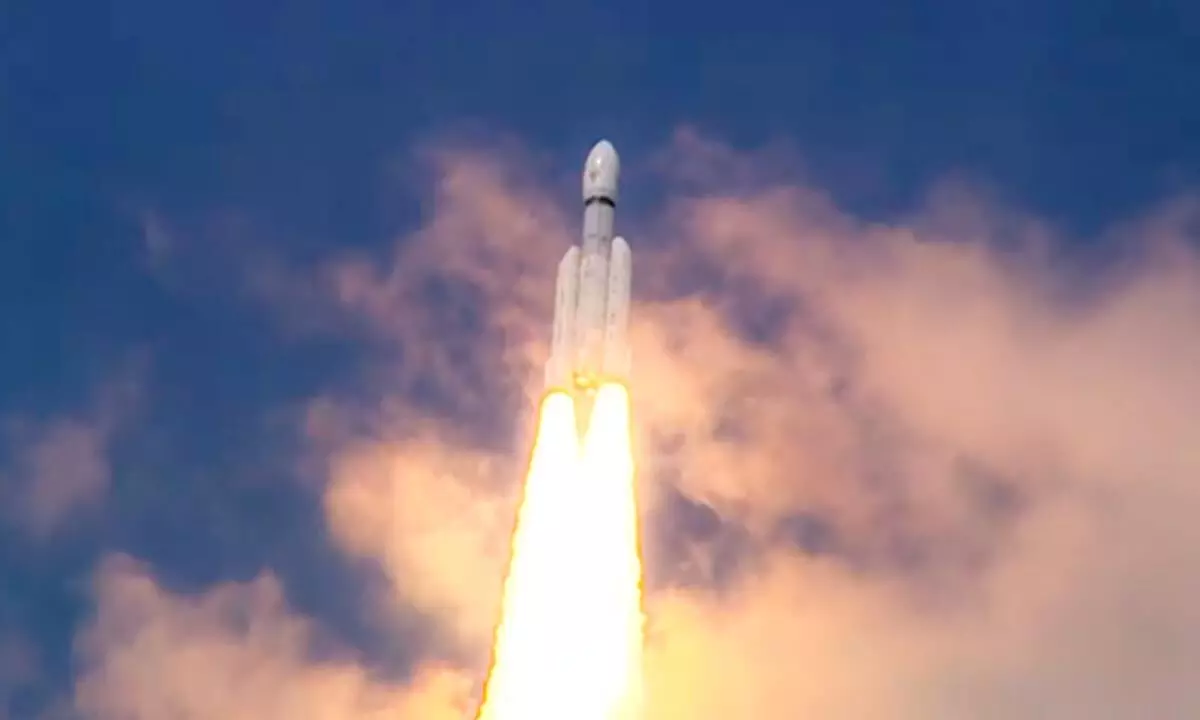India’s ‘Bahubali’ rocket LVM3 puts Chandrayaan-3 spacecraft into orbit
Share :

Young scientist from Belagavi contributes to Chandrayaan 3
India’s ‘Babubali’ rocket successfully put the moon spacecraft – Chandrayaan-3- into orbit on Friday afternoon in a copy book style.
Sriharikota (Andhra Pradesh): India’s ‘Babubali’ rocket successfully put the moon spacecraft – Chandrayaan-3- into orbit on Friday afternoon in a copy book style.
The country’s heavy rocket slung the 3.8 ton Chandrayaan-3 spacecraft in its intended earth orbit.
The rocket is nicknamed as `Bahubali’ as like the hero in the successful film lifts a heavy Lingam, the rocket carried the 3.8-tonne Chandrayaan-3 spacecraft.
From there it will be a long journey for Chandrayaan-3 as the distance between the earth and the moon is about 3.844 lakh km.
Speaking after the launch Indian Space Research Organisation (ISRO) Chairman S.Somanath ssaid that, “Chandrayaan-3 spacecraft has started its journey towards the moon. The LVM3 rocket orbited the spacecraft precisely at the intended orbit.”
Meanwhile, the MOS in PMO Jitendra Singh said that: “It is indeed a moment of glory to India. Thank you Team ISRO for making India proud. Prime Minister Narendra.”
The total project cost is about Rs.615 crore.
At about 2.55 p.m. the LVM3 rocket with a strong deep growl rose into the sky breaking free from the second launch pad here at Satish Dhawan Space Centre.
The 43.5 metre tall rocket weighing about 642 ton furiously rushed upwards with thick bright orange flame leaving behind an anaconda like long and thick white smoke.
The rocket is nicknamed as `Bahubali’ as like the hero in the successful film lifts a heavy Lingam, the rocket carries the 3.8-tonne Chandrayaan-3 spacecraft.
The other nickname is fat boy.
About 16-minutes into its flight, the rocket put into orbit Chandrayaan-3.
From there it will be over a month long journey for Chandrayaan-3 to reach its destination as the distance between the two planets is about 3.844 lakh km.
The Indian space agency will raise the spacecraft’s orbit by a series of manoeuvres to put it on Lunar Transfer Trajectory in the coming days.
Couple of days after the spacecraft enters lunar orbit, the lander will make a soft landing on the moon near its South Pole.
The Chandrayaan-3 spacecraft comprises a propulsion module (weighing 2,148 kg), a lander (1,723.89 kg) and a rover (26 kg), the ISRO said.
Incidentally, the Chandrayaan-2 payload also weighed about 3.8 ton with the orbiter weighing 2,379 kg, the Vikram lander 1,444 kg, including the Pragyan rover 27 kg.
During the Chandrayaan-2 mission ISRO had named the lander as Vikram in memory of country's space pioneer Vikram Sarabhai and rover Pragyan means wisdom in Sanskrit.
But this time around, ISRO has not officially named the lander and the rover.
Be that as it may, according to ISRO, the propulsion module has Spectro-polarimetry of Habitable Planet Earth (SHAPE) payload to study the spectral and Polari metric measurements of Earth from the lunar orbit.
The lander payloads are: Chandra’s Surface Thermophysical Experiment (ChaSTE) to measure the thermal conductivity and temperature; Instrument for Lunar Seismic Activity (ILSA) for measuring the seismicity around the landing site; Langmuir Probe (LP) to estimate the plasma density and its variations.
A passive Laser Retroreflector Array from NASA is accommodated for lunar laser ranging studies.
On the other hand, the rover will carry: Alpha Particle X-ray Spectrometer (APXS) and Laser Induced Breakdown Spectroscope (LIBS) for deriving the elemental composition in the vicinity of the landing site, ISRO said.
According to ISRO, the moon mission is divided into three phases – the earth centric phase (Pre-Launch, Launch and Ascent and Earth-bound Manoeuvre), the Lunar Transfer Phase (Transfer Trajectory), and the Moon Centric Phase (Lunar Orbit Insertion Phase, Moon-bound Manoeuvre Phase, Propulsion Module and Lunar Module Separation, De-boost Phase, Pre-landing Phase, Landing Phase, Normal Phase for Lander and Rover, Moon Centric Normal Orbit Phase -100 km circular orbit- for Propulsion Module).
With the successful launch the rocket has notched up an impeccable record of seven consecutive successful missions. This is the fourth operational flight of LVM3.
The LVM3 with a capacity to carry four ton, is a three stage/engine rocket with two strap-on motors powered by solid fuel. The second stage is a core liquid fuel booster and the third is the cryogenic engine.
Going forward, the lander is expected to make a soft-landing near the South Pole of the moon on August 23 or 24. It will descend to the moon from a height of about 100 km from the moon’s surface.
The soft landing is a tricky issue as it involves a series of complex manoeuvres consisting of rough and fine braking.
Imaging of the landing site region prior to landing will be done for finding safe and hazard-free zones.
Subsequent to the soft landing, the six-wheeled rover will roll out and carry out experiments on the lunar surface for a period of one lunar day which is equal to 14 Earth days.
The life of the payloads carried by the propulsion module post ejection of the lander is between three and six months. On the other hand, the mission life of the lander and the rover is 1 Lunar day or 14 earth days, ISRO said.
The success of Chandrayaan-3 mission will make India the fourth country in the world to land and ride on the Moon surface after the US, Russia and China.
India launched its first Moon mission Chandrayaan-1 in October 2008 using its light rocket Polar Satellite Launch Vehicle (PSLV) and the second mission on July 22, 2019 with the Geosynchronous Satellite Launch Vehicle-Mk III now renamed as LVM3.
The Friday moon mission is a follow up of the failed Chandrayaan-2 mission in 2019 when the lander named Vikram crashed on to the moon surface.
As regards the changes made in the lander this time as compared to the one that crash landed on the moon during the Chandrayaan-2 mission, a senior ISRO official told IANS that the lander has four motors instead of five.
The space agency has also carried out some changes in the software.







